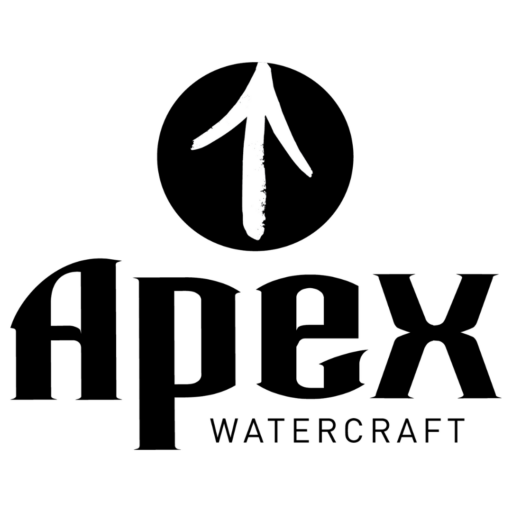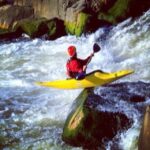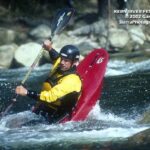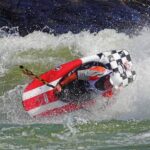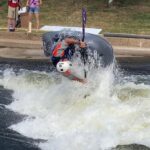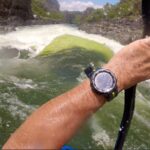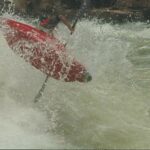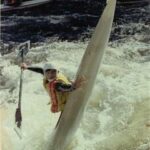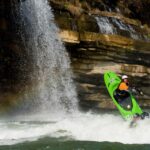Everyone who kayaks is concerned about their shoulders. Most of the time, for most people, little to no trauma exists for them, but for anyone who goes hard and long enough, you’ll likely experience injury at some point. I have watched amazing kayakers struggle with their shoulders and never really know how to fix them. Conflicting information, inaccurate information, incomplete information, or simply lack of effort on their part to get the job done. There are a lot of ways to do it wrong and nobody is unbreakable or lucky 100% of the time, so this blog is to help increase your chances of being lucky, and less likely to break, as well as more likely to fix yourself if you do become broken. My kayaking career has spanned since 1972 and full-time since 1984. I have had all kinds of pulls, hits, tweaks, slams, etc. while in my boat, and a few out of my boat as well. I have been very reslient against injury, but have had some very serious injuries that were the surgery kind as well, but never got surgery. Below are some photos that illustrate some of the different ways I have paddled over the years.
- (C) Darin McQuoid 530 526 1700
- Images of Jackson Kayak team-taken september 28, 2006
- DCIM123GOPRO
- Screenshot
- Eric Jackson and Clay Wright hamming it up in the Dynamic Duo in Rock Island, Tennessee.
- (C) Darin McQuoid 530 526 1700
Then there are those who are prone to shoulder issues, and that can be easily explained for most as well, and the solutions are the same.
The good news for paddlers is:
Prevention, readiness, and performance exercises and the recovery from injury exercises are the same.
The bad news for paddlers is that, in my experience, visiting dozens of top ranked doctors and physical therapists you’ll get a combo of good information, bad information, and most likely, most often, missing information that is key to success. My job here is to fill in the missing information, and replace the likely bad information with good information.
In full disclosure, I am not a doctor. However, any doctor who is good, will tell you that you, the patient is the best doctor and responsible for the healing and prevention of injury, not them. AND, unless the doctor absolutely needs the patient to be out pushing their body to the limits ASAP, 100% of the time, the concept that you can be injured and “just have to deal with it” at some level is normal. It is not normal to have a serious injury and expect it to be 100% again. That is what I expect and get, as long as I am willing to do the work.
Obviously every injury is different and every body is different. I am using the 80/20 rule here for both how to approach it, and the people who are reading it. 80% of you will find what I am offering to work and 20% of the full effort possible will create 80% of the desired results.
Lastly, but my personal success rate has been so high in keeping my shoulders, or rehabing them, with easy to see in action cause/effect results. The concept I am using is so simple that you don’t need to know detailed anatomy, the name of your tendons that were injured, etc. etc. if you don’t want to.
However, here are a few things to know that include some anatomy and this will explain the overarching concept I follow and the why’s.
I am going to simplify and you can hit me up with all of the details you think I am missing, and I will just say, “that doesn’t matter”. Here is what I think matters and seems to only matter.
Healthy shoulders: this is where the bones are aligned properly and held into place properly by your tendons and muscles. The arms can move all around and the bones stay in place, not stretching or pinching tendons and causing irritation, tearing, or swelling.
There are two main types of tendons/muscles- the “little ones” which are alignment ones, mostly- “rotator cuff”. They are not super strong, they are the easiest to injure. Then there are the larger tendons and muscles. The one that kayakers struggle with most is the “long head of the biceps tendon”. The reason for this is because it runs through a very limiting groove that doesn’t have extra room for inflammation. Kayakers stress this tendon a lot and it swells up and makes all movements painful. If you want to know which one that is, take your right hand and reach over to your left shoulder cupping it. Where your thumb is dig down into the front of your shoulder, that pain you feel is you pressing on your biceps tendon.

More about the issues people have and the solutions, the nuts and bolts of what is going on.. simplified.
When you injure any tendon, but especially your long head of the biceps, or any tendon that allows your shoulder to move around and pinch the long head, or any other tendon, you get in a cycle of one failed recover after another, mostly because…
- PTs and Doctors recommend that you Rest your shoulder first. Yes, you’ll also get good information, such as- “Take anti-inflammatories, ice”, but they also recommend resting it for some period- often for a couple of weeks. What happens when you rest it, immobilize it? 90% of the time you are immobilized in a contracted position. (Think sling). During the next 3-10 days or more, your injured/irritated tendon will begin to heal. However, the fibers that were torn and heal, which are only part of the entire tendon (unless you ripped it in 1/2, which is not what we are talking about for 99% of you out there), heal shorter than the rest of the tendon, since you are not moving it, and it is in its shorter form due to being in a sling. The very first time you use it, often in the first 5 minutes if any real exercise, those fibers that were injured will immediately tear again, as they are the first fibers to engage when you stretch your arm out and pull or push. Since they are tighter than the rest of the tendon, they take the initial force and rip, putting you right back where you were before you rested, at square 1. Can you get “active recovery” advice, of course, but not as a rule and it isn’t treated as a MUST DO, which is is a must do! What is active recovery/healing? It means that you are using your injured shoulder within a couple of days of the injury. The use is light and with minimum pain. Your job is first to get swelling down (800MG of Advil 3-4 times/day, ICE) first, and then begin light work with it. The use and putting your tendons in motion, assure that the fibers heal elongated and are the same length as the others so they won’t tear when you put stress on them after they fully heal. Examples of light use are 5 pound dumbbells, or a very light elastic band.
- You don’t get swelling down- swelling is the second biggest culprit to your pain, besides the injury, and ultimately it gets to be #1 within a few weeks. Swelling is bad for your
First ones- your warm-ups: There are exercises that improve the strength and motion of your rotator cuff exercises, these are usually prescribed by Physical Therapist for recovery. The reason to do them is that they isolate those muscles and tendons and prepare them for action. It will assure that you are less likely to injure them, and that they will hold your shoulder in position under stress better. Basically, if you don’t do them, those stabilizers will have less range of motion, be weaker and more likely to be injured.
The Warm-Up
I just filmed this a few minutes ago doing a workout with KC to help with the visuals:
Grab a set of 10-12 pound dumbells (8lbs if you are under 120 pounds)- this warm-up takes 2 minutes.
#1- 10 x straight arm, thumbs up dumbell raises in front of you. Only go from your side, to arms parallel with the ground. (don’t lift overhead)
#2- 10x straight arm, palms down, raises to your sides, again from thigh to arms parallel to the ground.
#3- 10x sword raises. Pretend to pull a sword out of a sheath at your side, and lift it overhead. The objective is for you to be outwardly rotating your shoulder through the motion. This is a dumbell replacement for using the Thera Bands and doing outward rotations of your shoulder.
#4- 10x Overhead presses
#5- 10x Curls
#6- 10x bent over reverse flys.
#7- bounce around, shake it off, and you should feel pretty warmed up and loose and ready to do your big muscles.
The Bread and Butter: The other Critical part of the equation is: Packing your shoulders with the big resilient, strong, protector muscles.
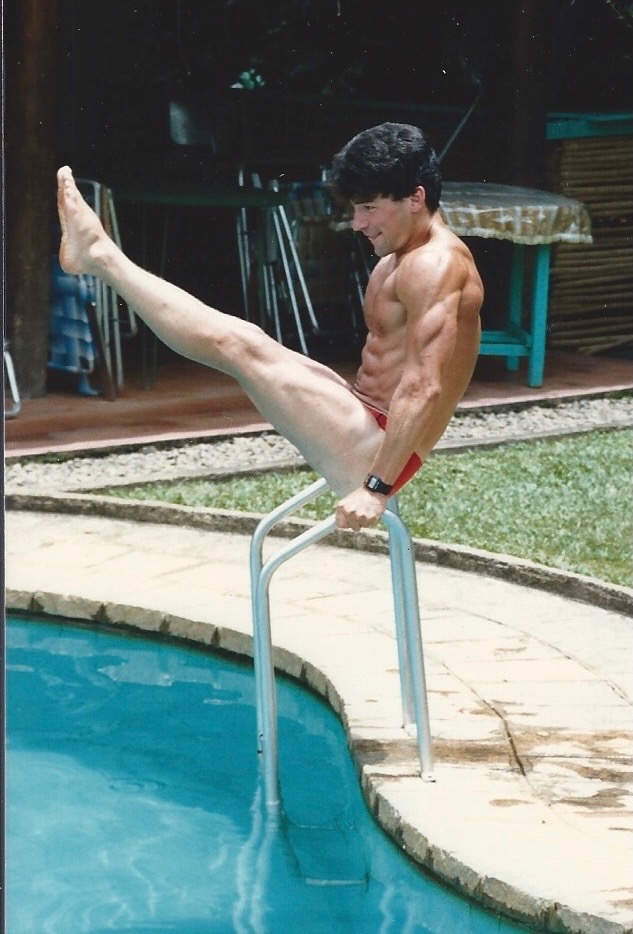
Then there is the secret sauce for my personal program- that is the big muscles that pack out your shoulders and actually do most of the work- Chest, Deltoids, back, etc.. Bench, pull-ups, dips. Bench, pull-ups and dips…. This is like putting money in a bank for emergency funds. Without these, you are living paycheck to paycheck and any stress to your shoulder and your little rotator cuff tendons will take the brunt of the abuse and get torn, stressed, swollen, and chronically irritated. Basically, if injured you’ll feel like you have a permanent injury and not know why it never heals. It never heals because you simply don’t have enough muscle in the right places to hold your shoulder joint from moving around and irritating the tendons.
OK, now some more details on HOW to do your Bench, Pull-ups/Chin-ups, and Dips and more.
The technique is important for two main reasons.
#1- the prescribed technique is low impact on your tendons, which is important if you are already on the edge of having issues, and extremely important if you have shoulder issues.
#2- these techniques are designed to prepare you shoulders for the real world that exists in kayaking, such a freestyle in a big hole or wave, or some crazy big braces, rolls, where you bang the bottom, or get a big tug by the water, etc..
Overall technique for the weights:
Your warm-ups/Rotator cuff- medium speed up (1 second), and slower down, 1.5 seconds. If you feel any pain, pull/pinch your shoulder blades backward. Most people suffer from slouching forward rolling shoulders due to TV, Computers, and other non-active situations. Also think about tightening the muscles around your shoulder to hold everything tight and in place so the shoulder is rotating, but not being pulled out of joint.
Bench Press- or Push-Ups: If I have my weight room, I’ll do bench press, if not, I’ll do push ups. Bench allows you to use more weight easier and a little more range of motion than hands on the floor. It is easy to injure your shoulder doing bench press if you are already struggling with it. To avoid that, work your way up with weight, starting light first, WAY lighter than you think you can do. When you bring the weight down to your chest- 2 seconds, and stop, and then tighten your shoulders and back up in 1 second. There should be very little to no pain. My shoulders require some warm-up to feel good. My first set and first 3-4 reps are where most of the risk to injury is. Be very conscious about the tight shoulders. Do 10 reps, or if a very lightweight, 15. Ideally you’ll do three sets of 10, with increasing or same weight. I typically do 155 x 10 x 3 if I have not been doing a ton of weights. I’ll get up to 165-175 max. I do the bench not to see how much bench I can lift, but to tie my shoulders in place. If doing push-ups, I do 100 reps in the minimum number of sets. I try to do them in two sets of 50, but if I haven’t been doing them often, it will be in three sets.
Chin-ups: I do three sets of 10. (See the video above for visuals) One set of pull-ups, then chin-ups narrow grip, then behind the head wide grip. The key here is to allow your arms to go to full extension, fully straight and then up. This assures you are strong when fully extended. If you do the short range of motion that 90% of people do (arm are still bent and you pull yourself back up), you’ll not be prepared for a fully extended arm (which is where most kayakers hurt themselves). If you can’t pull yourself up, use your legs to take some weight off. Same as bench, slow (2 seconds on the negative, and 1 second up). The Reverse grip (chin-up) is important to have a narrow grip so the arms get pulled against your ears when you are hanging at the bottom and that range of motion is critical. It is a great stretch, but also strengthens your arms/shoulders in that position.
Dips: The most over looked exercise and perhaps the most important for kayakers. When you paddle you pull your elbows in the same motion as a pull-up. Dips are the opposite and prevent muscle imbalance. You NEED these muscles to prevent shoulder injuries. Dips are very hard for anyone who hasn’t done them, but they get easier very quickly and you get much better with little time. I do sets of 20 dips with a 40 pound weight vest. I take these seriously as they fix your shoulder up nicely. If you have an injury, you have to hold your shoulders tight on the way down or they will hurt. If they hurt, use your legs to take some weight off of them. KC couldn’t do any dips 6 months ago, but is doing them well now, for example. His shoulders are ready to rock!
If you do three sets, three times/week for 3 months, you’ll be a new woman/man and your shoulders will be way more prepared for what might happen.
Yes, I also do Curls, Rows, Abs, and overhead presses to round out a weight routine. It takes me less than 30 minutes to do three sets, and most often around 20 minutes as I do it as a circuit and don’t rest in between. 20 minutes 3 times/week and you will be so much stronger! If you have bad shoulders, you’ll likely have fixed them. I have taken very seriously injured shoulders from zero paddling possible to fully functional and no pain about 5 times in my life. I have also had many smaller issues that needed attention from strains and impacts. Doctors have recommended surgery for me and I have never had surgery. I think it is worth the effort.
Stretching- this is a touchy subject as you want to have “Full Range of Motion” and not have your muscles/joints stop you from being able to get into the positions required during kayaking or any other activity. However, extreme flexibility isn’t necessary or desired as you want your muscles to keep your limbs in place. Here is what I consider the basics you should do.
If you have any questions, let me know!
🙂
EJ
